


Next: Conclusions
Up: Favorite Locations
Previous: Calendulaceum and the Appalachian
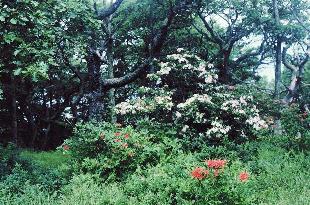 The very finest display of native azaleas that I have ever seen though is on Gregory Bald, another open bald of about 10 acres on the North Carolina - Tennessee
border in the Smokies. At an elevation of 4949 feet, Gregory Bald is noted for
its "hybrid swarm" of native azaleas. Four native azalea species are believed
to be present on the bald (calendulaceum , cumberlandense, arborescens, and viscosum) and over the years they have been hybridizing to create azaleas in almost
every conceivable color. The display lasts many weeks with peak usually being near the end of June.
The very finest display of native azaleas that I have ever seen though is on Gregory Bald, another open bald of about 10 acres on the North Carolina - Tennessee
border in the Smokies. At an elevation of 4949 feet, Gregory Bald is noted for
its "hybrid swarm" of native azaleas. Four native azalea species are believed
to be present on the bald (calendulaceum , cumberlandense, arborescens, and viscosum) and over the years they have been hybridizing to create azaleas in almost
every conceivable color. The display lasts many weeks with peak usually being near the end of June.
I remember Fred Galle and others talking about this unique spot many years before I made my first trip. According to one story, Fred was working on his doctoral thesis while on Gregory Bald when a bear attacked and carried off his research notes. Unfortunately, he never completed his degree because of that loss. I made my first trip to Gregory in 1995, but now I must make an annual pilgrimage, but I also keep a close lookout for bears.
There are two trails up to Gregory Bald, both originating in Cades Cove, but neither one is an easy hike. The longer but more scenic trail via Forge Creek to Gregory Ridge begins along rushing stream waters, and winds through a magnificent virgin forest of hemlocks and thickets of Rhododendron maximum. The trail eventually gains elevation as it ascends through dryer forests of hardwoods, kalmia, and beds of galax, finally reaching the bald. The hike takes about 3.5 hours and there is an elevation change of approximately 3000 feet. The alternative route via the Parson's Branch Road and Hannah Trail cuts off about 45 minutes and 1000 feet in elevation, but requires that one travel by car on a one-way, primitive road from Tennessee into North Carolina. This road has numerous fords and is often closed due to bad weather. There is also limited parking where the Hannah Trail starts.
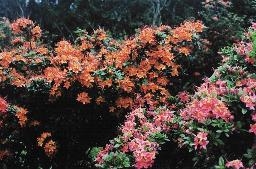 Once on the top of Gregory, the difficulties of the hike are forgotten as one becomes enthralled by the color, fragrance, and sheer floral beauty of the native azaleas there. The predominant azalea color is typically orange red similar to cumberlandense and the flower size is about 1 to 1.5 inches in diameter depending upon the clone. Growing throughout the bald though are whites, creams, yellows, golds, pale pinks, deep pinks, fuchsias, corals, reds, and wondrous blends. There are larger flowered forms and many have distinctive foliage qualities too. Unless chased off the mountain by fierce thunderstorms or the threat of nightfall, I usually stroll for hours through acres of azaleas as though I am judging some enormous flower show. I keep trying to decide which are the best of the best, but there are so many from which to choose.
Once on the top of Gregory, the difficulties of the hike are forgotten as one becomes enthralled by the color, fragrance, and sheer floral beauty of the native azaleas there. The predominant azalea color is typically orange red similar to cumberlandense and the flower size is about 1 to 1.5 inches in diameter depending upon the clone. Growing throughout the bald though are whites, creams, yellows, golds, pale pinks, deep pinks, fuchsias, corals, reds, and wondrous blends. There are larger flowered forms and many have distinctive foliage qualities too. Unless chased off the mountain by fierce thunderstorms or the threat of nightfall, I usually stroll for hours through acres of azaleas as though I am judging some enormous flower show. I keep trying to decide which are the best of the best, but there are so many from which to choose.
Members of our study group have given many of the best forms special names, some of which are very descriptive yet others are more whimsical. In an article I wrote for the
ARS Journal in 1998 called
"Return to Gregory Bald"
[5], I discussed my "Top Ten" on the bald. I gave names to some of the favorites, like "Gregory Christmas Red", one of the older plants on the bald with deep red flowers and dark green leaves that remind me of Christmas poinsettias and holly leaves. Another favorite is "Gregory Blush", a large flowered white brushed with pale pink that carries a bold yellow flare. The plant is on the right to greet visitors as they enter the bald from the Forge Creek Trail. Another showstopper is an enormous plant we call the "Hannah Trail Coral", a brilliant coral orange that grows on the other side where the Hannah Trail enters the bald. Images of these and many other selections can be seen on my web site.
Some Special Plants on Gregory
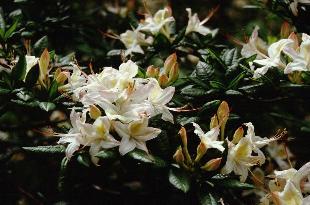
Gregory Blush
|
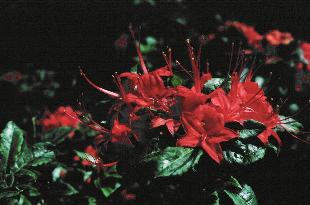
Gregory Christmas Red
|
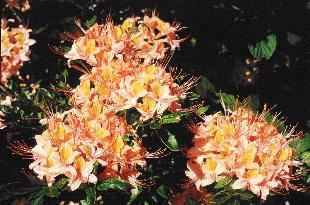
Gregory Salmon
|
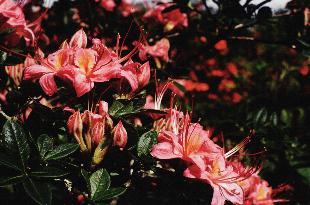
Gregory Candy Stripe
|
In the middle of the bald are so many wonderful plants it is really hard to choose the best forms, but each year I try. "Gregory Candy Stripe" has a large rose pink flower with a yellow flare and beautiful bluish green foliage. We gave it the name because the pink flower buds are striped with white before they open, giving a striking floral effect. It blooms later than many of the others but it is surely one of the best on the bald. Another one of the top plants we call "Salmon Balls" because the round trusses reminded us of balls of poached salmon. Perhaps we should change the name to "Gregory Salmon" if it is ever registered or introduced. Two other favorites that grow side by side are "Gregory Cover Girl", so named because a picture of this plant with its deep pink flowers and broad yellow blotch was printed on the cover of the ARS Journal in 1996 [9]. Right beside this plant is another striking azalea we call "Gregory Goldilocks", a brilliant golden orange. One of the best plants on the bald is surely "Gregory Fuchsia" with 2-inch flowers of fuchsia pink with a yellow flare. The plant has wonderful glossy green foliage, too.
Other Goodies
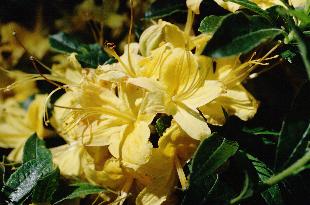
Gregory Big Yellow
|
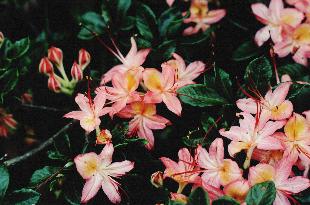
Gregory Kalaedescope
|
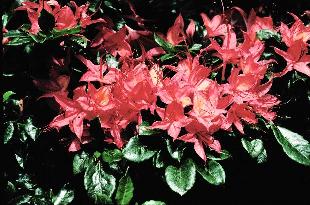
Gregory Fuchsia
|
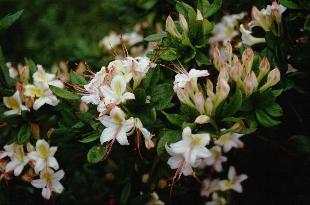
Gregory Rattlesnake Cream
|
There are many other plants on the bald that we have identified as excellent forms. We have been calling them by strange names such as "Far Side Pink" because it is a nice lavender pink on the far side of the bald away from most of the other favorites. There is "Fasti Pink", so named because it has an upright or fastigiated plant habit and soft rose pink flowers. A huge plant growing right along the path in the center of the bald we call "Pink by the Path". It has deep rose pink flowers with an orange blotch. Finally, there is an exceptional plant with creamy white flowers brushed in pink we call "Rattlesnake Cream". We gave it the name because it grows next to a place where we spotted a huge rattlesnake one year. We look out for rattlesnakes as well as bears on Gregory now.
There are other exciting hybrid swarms of native azaleas, such as along the Appalachian trail near Copper Bald in North Carolina or at Audra State Park in West Virginia. The catalyst behind hybrid swarms is not clear, though. Calendulaceum seems to be involved in these swarms, but being tetraploid it should produces sterile offspring in primary crosses with the other diploid natives. Perhaps when several diploid species such as viscosum, arborescens, and cumberlandense cross with one another first, then these primary hybrids produce unreduced gametes that will allow fertile progeny when crossed with calendulaceum. That would imply that many of the stunning hybrids in these swarms could be tetraploid. Of course, cytological studies would be needed to verify such a conjecture.
Other Pages on Gregory Bald



Next: Conclusions
Up: Favorite Locations
Previous: Calendulaceum and the Appalachian
Donald W. Hyatt
2001-06-26
 The very finest display of native azaleas that I have ever seen though is on Gregory Bald, another open bald of about 10 acres on the North Carolina - Tennessee
border in the Smokies. At an elevation of 4949 feet, Gregory Bald is noted for
its "hybrid swarm" of native azaleas. Four native azalea species are believed
to be present on the bald (calendulaceum , cumberlandense, arborescens, and viscosum) and over the years they have been hybridizing to create azaleas in almost
every conceivable color. The display lasts many weeks with peak usually being near the end of June.
The very finest display of native azaleas that I have ever seen though is on Gregory Bald, another open bald of about 10 acres on the North Carolina - Tennessee
border in the Smokies. At an elevation of 4949 feet, Gregory Bald is noted for
its "hybrid swarm" of native azaleas. Four native azalea species are believed
to be present on the bald (calendulaceum , cumberlandense, arborescens, and viscosum) and over the years they have been hybridizing to create azaleas in almost
every conceivable color. The display lasts many weeks with peak usually being near the end of June.








